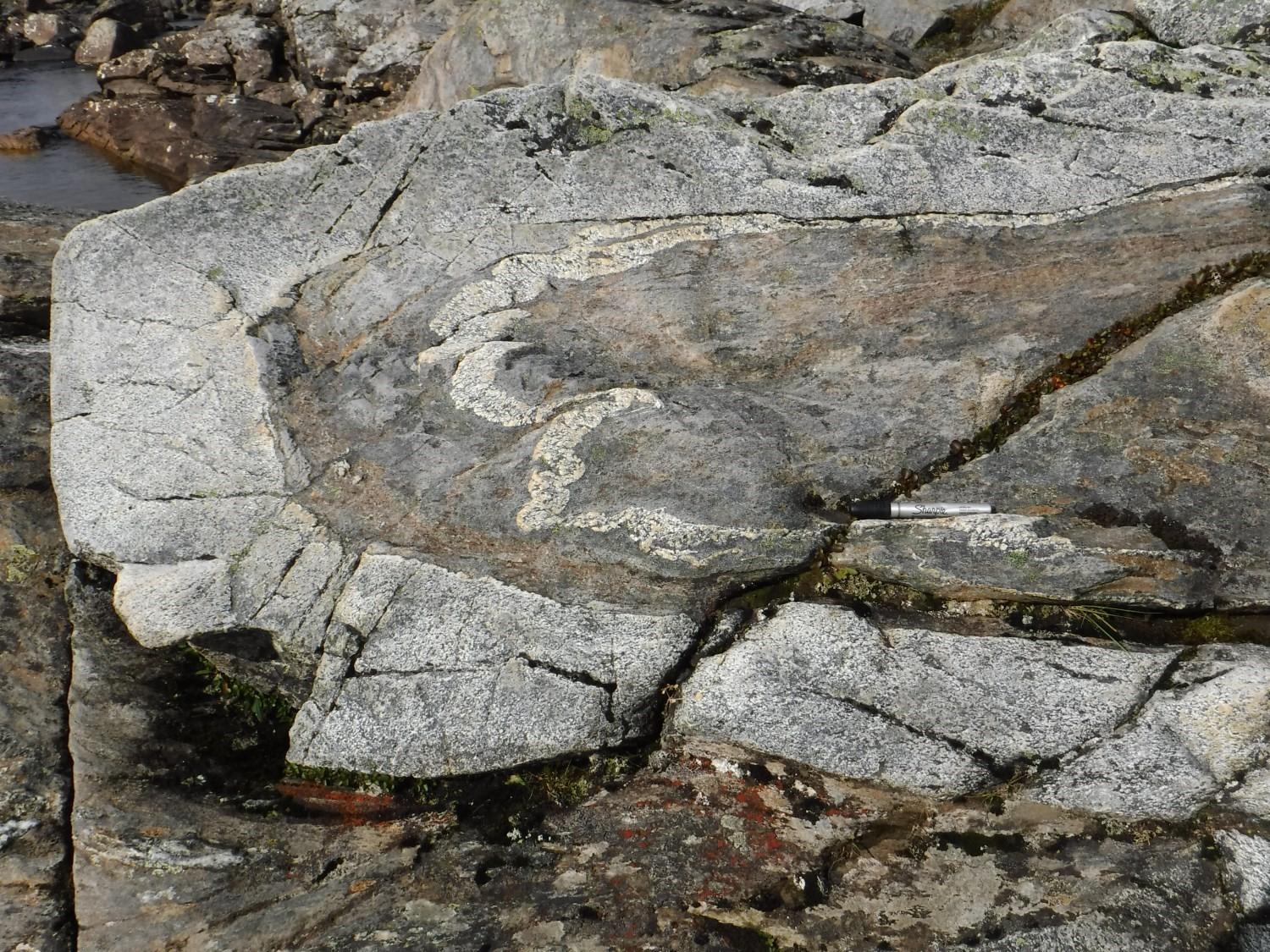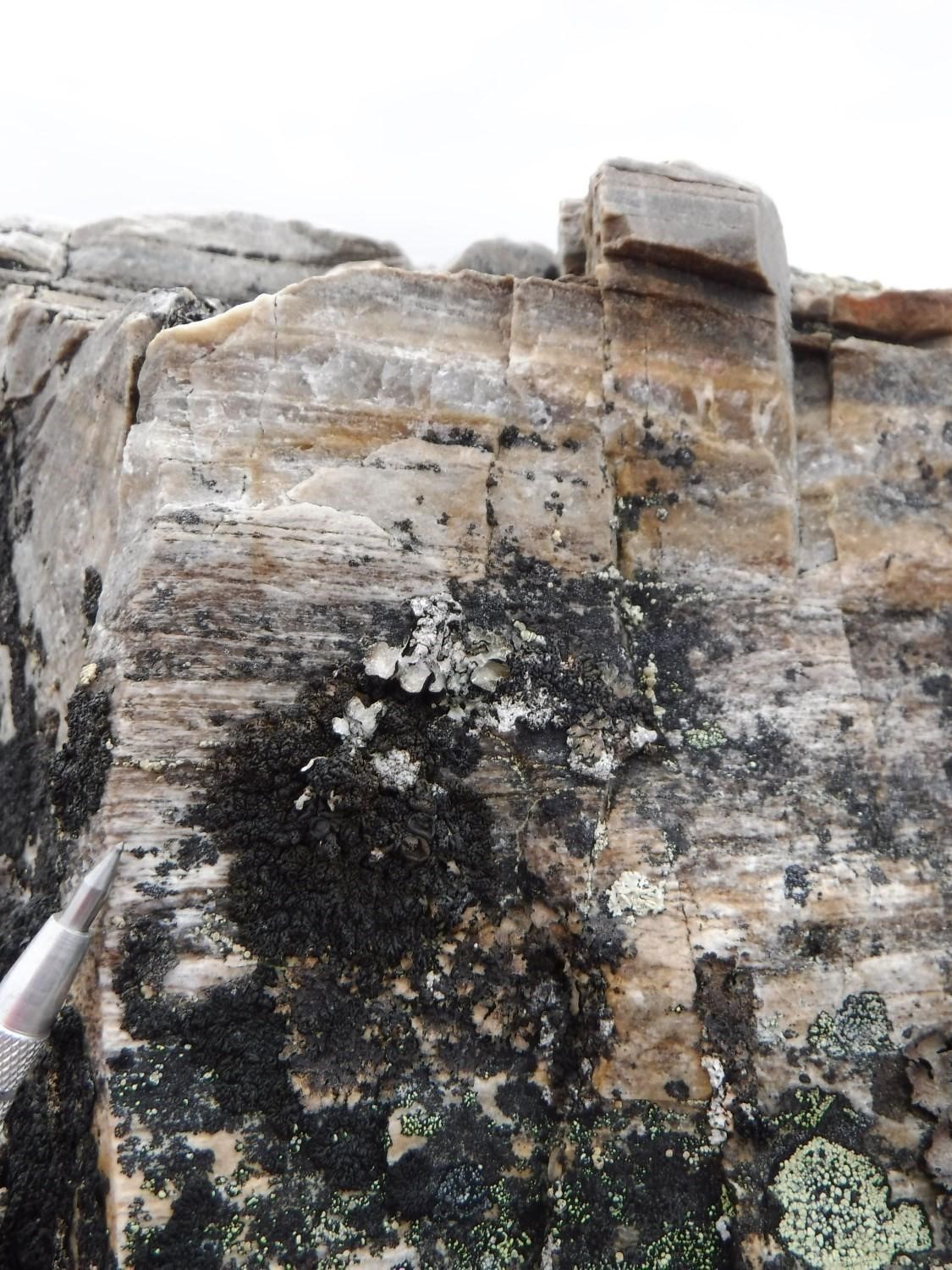
DISCLAIMER: This English version is translated from the original French. In case of any discrepancy, the French version shall prevail.
| Author: | Beaudette et al., 2020 |
| Age: | Paleoproterozoic |
| Stratotype: | None |
| Type area: | Northern part of the Parent Lake area (NTS sheet 35G11) |
| Geological province: | Churchill Province |
| Geological subdivision: | Ungava Orogen |
| Lithology: | Metamorphic sedimentary rocks |
| Category: | Lithodemic |
| Rank: | Complex |
| Status: | Formal |
| Use: | Active |
None
Background
The Qaaneq Complex was introduced by Beaudette et al. (2020) to individualize metamorphic sedimentary rocks located east of the Ammaluttuq Fault in the northern part of sheet 35G11.
Description


 The Qaaneq Complex consists of paragneiss containing small centimetric quartzitic meta-arenite layers. Paragneiss are brownish beige in altered surface and whitish grey in fresh exposure. Meta-arenite is light grey or brownish beige in altered patina and fresh exposure. Paragneiss is commonly fine grained, foliated and of variable composition. Millimetric to decimetric compositional banding is evidenced by variations in the main mineral contents, including biotite, a quartz-feldspar assemblage and locally garnet or muscovite. Plagioclase accounts for 5 to 60% of lithology. It is partially to totally replaced by non-oriented sericite flakes or by a sericite-epidote ± titanite assemblage. Anhedral quartz in isolated crystals or in clusters accounts for 20% to 75% of the volume of the rock. It is generally fine, even grained or granoblastic, as evidenced by triple point junctions between crystals. Undulatory extinction is commonly observed in samples with coarser crystals. Quartz is also observed as rounded inclusions in biotite crystals.
The Qaaneq Complex consists of paragneiss containing small centimetric quartzitic meta-arenite layers. Paragneiss are brownish beige in altered surface and whitish grey in fresh exposure. Meta-arenite is light grey or brownish beige in altered patina and fresh exposure. Paragneiss is commonly fine grained, foliated and of variable composition. Millimetric to decimetric compositional banding is evidenced by variations in the main mineral contents, including biotite, a quartz-feldspar assemblage and locally garnet or muscovite. Plagioclase accounts for 5 to 60% of lithology. It is partially to totally replaced by non-oriented sericite flakes or by a sericite-epidote ± titanite assemblage. Anhedral quartz in isolated crystals or in clusters accounts for 20% to 75% of the volume of the rock. It is generally fine, even grained or granoblastic, as evidenced by triple point junctions between crystals. Undulatory extinction is commonly observed in samples with coarser crystals. Quartz is also observed as rounded inclusions in biotite crystals.
Ferromagnesian minerals account for 5% to 40% of the paragneiss composition and consist of, in order of abundance, fine to medium biotite, actinolite, hornblende and chlorite. Muscovite is not a diagnostic mineral of Qaaneq Complex paragneiss; it represents 0% to 25% of the rock. On average, 2% subhedral pink garnet is observed in layers richer in mica. The poikiloblastic texture of garnet is evidenced by numerous inclusions of biotite, quartz and opaque minerals. Microscopically, the arrangement of these inclusions indicates a slight rotation of syn-kinetic origin of garnet in some samples. The foliation is marked by the preferential orientation of minerals, with the exception of late sericite sheaves and some epidote and titanite crystals, interpreted as post-kinetic. Macroscopic samples of quartzitic meta-arenite have a composition largely dominated by light grey quartz crystals. Light beige specimens contain feldspars replaced by sericite; brownish specimens may contain iron oxides.
Thickness and Distribution
The Qaaneq Complex extends over 8 km and is oriented NW-SE. Its apparent thickness does not exceed 1.5 km.
Dating
None.
Stratigraphic Relationship(s)
The Qaaneq Complex is possibly cut by the Qikirtalialuk and Iqiat suites.
Paleontology
Does not apply.
References
Publications Available Through SIGÉOM Examine
BEAUDETTE, M., BILODEAU, C., MATHIEU, G. 2020. Geology of the Parent Lake Area, Ungava Orogen, Nunavik, Quebec, Canada. MERN. BG 2020-04, 1 plan.
Suggested Citation
Ministère de l’Énergie et des Ressources naturelles (MERN). Qaaneq Complex. Quebec Stratigraphic Lexicon. https://gq.mines.gouv.qc.ca/lexique-stratigraphique/province-de-churchill/complexe-de-qaaneq_en [accessed on Day Month Year].
Contributors
|
First publication |
Carl Bilodeau, P. Geo., M.Sc. carl.bilodeau@mern.gouv.qc.ca; Mélanie Beaudette, GIT, B.Sc. melanie.beaudette@mern.gouv.qc.ca (redaction) Mehdi A. Guemache, P. Geo., Ph.D. (coordination); James Moorhead, P. Geo., M.Sc. (critical review); Simon Auclair, P. Geo., M.Sc. (editing); Céline Dupuis, P. Geo., Ph.D. (English version); Ricardo Escobar Moran (HTML editing). |

